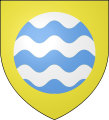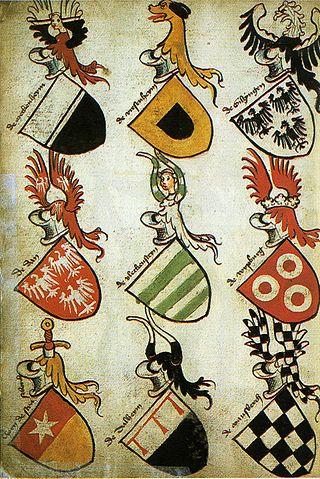
Heraldry is a discipline relating to the design, display and study of armorial bearings, as well as related disciplines, such as vexillology, together with the study of ceremony, rank and pedigree. Armory, the best-known branch of heraldry, concerns the design and transmission of the heraldic achievement. The achievement, or armorial bearings usually includes a coat of arms on a shield, helmet and crest, together with any accompanying devices, such as supporters, badges, heraldic banners and mottoes.
In heraldry, argent is the tincture of silver, and belongs to the class of light tinctures called "metals". It is very frequently depicted as white and usually considered interchangeable with it. In engravings and line drawings, regions to be tinctured argent are either left blank, or indicated with the abbreviation ar.

Tinctures are the colours, metals, and furs used in heraldry. Nine tinctures are in common use: two metals, or and argent ; the colours gules (red), azure (blue), vert (green), sable (black), and purpure (purple); and the furs ermine, which represents the winter fur of a stoat, and vair, which represents the fur of a red squirrel. The use of other tinctures varies depending on the time period and heraldic tradition in question.
In heraldry, variations of the field are any of a number of ways that a field may be covered with a pattern, rather than a flat tincture or a simple division of the field.
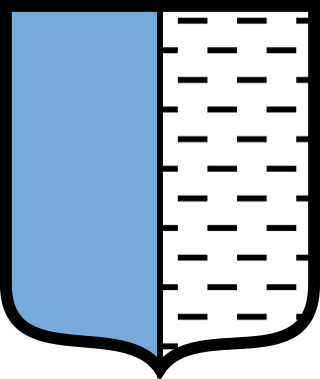
Bleu celeste is a rarely occurring and non-standard tincture in heraldry. This tincture is sometimes also called ciel or simply celeste. It is depicted in a lighter shade than the range of shades of the more traditional tincture azure, which is the standard blue used in heraldry.
In heraldry, an ordinary is one of the two main types of charges, beside the mobile charges. An ordinary is a simple geometrical figure, bounded by straight lines and running from side to side or top to bottom of the shield. There are also some geometric charges known as subordinaries, which have been given lesser status by some heraldic writers, though most have been in use as long as the traditional ordinaries. Diminutives of ordinaries and some subordinaries are charges of the same shape, though thinner. Most of the ordinaries are theoretically said to occupy one-third of the shield; but this is rarely observed in practice, except when the ordinary is the only charge.
In heraldry, a charge is any emblem or device occupying the field of an escutcheon (shield). That may be a geometric design or a symbolic representation of a person, animal, plant, object, building, or other device. In French blazon, the ordinaries are called pièces, and other charges are called meubles.

A roundel is a circular disc used as a symbol. The term is used in heraldry, but also commonly used to refer to a type of national insignia used on military aircraft, generally circular in shape and usually comprising concentric rings of different colours. Other symbols also often use round shapes.

Canting arms are heraldic bearings that represent the bearer's name in a visual pun or rebus.
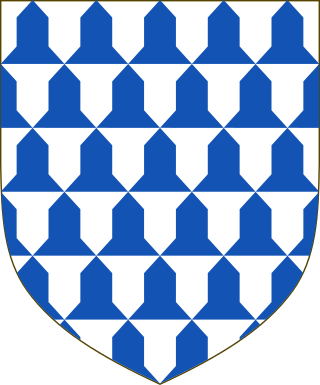
Vair, originating as a processed form of squirrel fur, gave its name to a set of different patterns used in heraldry. Heraldic vair represents a kind of fur common in the Middle Ages, made from pieces of the greyish-blue backs of squirrels sewn together with pieces of the animals' white underbellies. Vair is the second-most common fur in heraldry, after ermine.

The rule of tincture is a design philosophy found in some heraldic traditions that states "metal should not be put on metal, nor colour on colour". Heraldic furs such as ermine and vair, and charges described as "proper", are generally exempt from the rule of tincture.
In British heraldry, vert is the tincture equivalent to green. It is one of the five dark tinctures called colours.
A goutte is a droplet-shaped charge used in heraldry. Its name derives from the Old French for "droplet".

The rose is a common device in heraldry. It is often used both as a charge on a coat of arms and by itself as an heraldic badge. The heraldic rose has a stylized form consisting of five symmetrical lobes, five barbs, and a circular seed. The rose is one of the most common plant symbols in heraldry, together with the lily, which also has a stylistic representation in the fleur-de-lis.

Fraser Herald of Arms is the title of one of the officers of arms at the Canadian Heraldic Authority in Ottawa. Like the other heralds at the Authority, the name is derived from the Canadian river of the same name. Since the inception of the office, Fraser Herald of Arms has been the principal artist of the Canadian Heraldic Authority. As such, Fraser is responsible for overseeing the artwork created for all grants of arms emanating from the Authority.
In heraldry and heraldic vexillology, a blazon is a formal description of a coat of arms, flag or similar emblem, from which the reader can reconstruct the appropriate image. The verb to blazon means to create such a description. The visual depiction of a coat of arms or flag has traditionally had considerable latitude in design, but a verbal blazon specifies the essentially distinctive elements. A coat of arms or flag is therefore primarily defined not by a picture but rather by the wording of its blazon. Blazon is also the specialized language in which a blazon is written, and, as a verb, the act of writing such a description. Blazonry is the art, craft or practice of creating a blazon. The language employed in blazonry has its own vocabulary and syntax, which becomes essential for comprehension when blazoning a complex coat of arms.
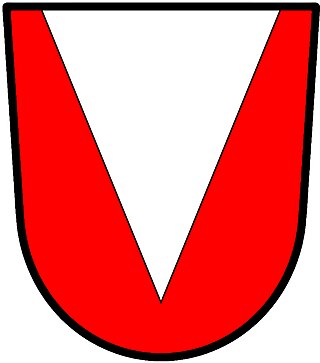
In heraldry, a pile is a charge usually counted as one of the ordinaries. It consists of a wedge emerging from the upper edge of the shield and converging to a point near the base. If it touches the base, it is blazoned throughout.

The coat of arms of the London Borough of Camden were granted on 10 September 1965. The borough was formed by the merger of three former boroughs, namely the Metropolitan Borough of Hampstead, the Metropolitan Borough of Holborn and the Metropolitan Borough of St. Pancras, from whose arms elements were utilised in the arms of the new borough.

The coat of arms of Oxford is the official heraldic arms of Oxford, England, used by Oxford City Council.

A roundel is a circular charge in heraldry. Roundels are among the oldest charges used in coats of arms, dating from the start of the age of heraldry in Europe, circa 1200–1215. Roundels are typically a solid colour but may be charged with an item or be any of the furs used in heraldry. Roundels are similar to the annulet, which some heralds would refer to as a false roundel.




